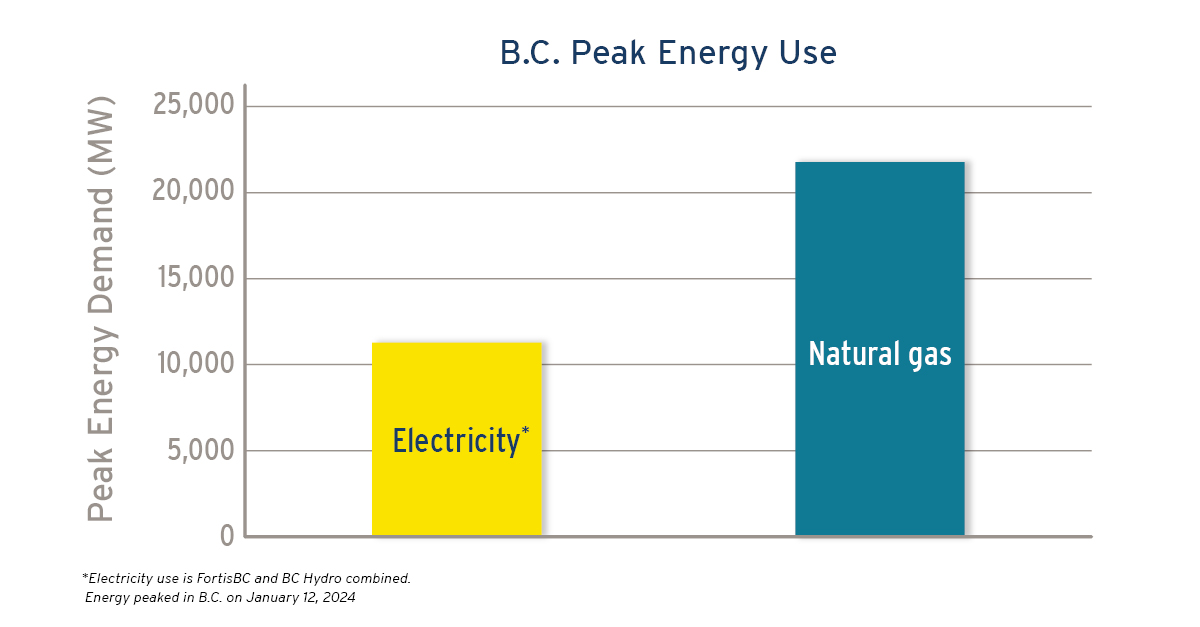B.C.’s energy systems work together to meet demand during cold snap
Feb 2, 2024
SURREY, B.C.—February 2, 2024: Statement attributed to Joe Mazza, vice president of energy supply and resource development, FortisBC:
“FortisBC’s customers’ demand for energy peaks during periods of colder weather, which is precisely what we experienced during the first cold snap of the winter season with an increase in demand for both gas and electricity.
“Customers rely on both the gas and electricity systems working together to deliver the energy they need to keep their homes and businesses safe and warm during times like this. To meet peak demand, an energy system either needs to have the ability to produce enough energy to meet it or have the ability to store energy to use when energy needs increase. An advantage of the gas system is its ability to easily and affordably store large volumes of energy, whether in dedicated gas storage, such as liquefied natural gas facilities or even within the lines themselves. As we look for ways to meet climate action goals, leveraging this existing gas infrastructure to carry renewable and low-carbon gases,1 such as Renewable Natural Gas2 and hydrogen in the future, will help reduce emissions while meeting British Columbia’s energy needs, especially during peak periods like winter.
“For our gas customers across the province, energy use can triple during the colder winter months. For our electricity customers in B.C.’s Southern Interior, electricity use can increase by approximately 25 per cent on the coldest days of the year. As the winter season continues, we encourage customers to monitor their energy use and take proactive steps to improve energy efficiency in their homes or businesses, which could help lower energy use and reduce monthly bills.”
For more information on home heating and energy use, please visit fortisbc.com/winteruse.

Backgrounder:
Space heating accounts for the largest share of total household energy use for most British Columbians, and with colder winter weather, it can take more energy to maintain a comfortable temperature.
- FortisBC’s gas system delivered approximiately double the energy B.C.’s electricity systems provided on Friday, January 12, 2024 when the province was at its coldest, with electrical providers delivering 11,300 megawatts (MW) compared to FortisBC’s gas system delivering 21,763 MW at the highest point of demand. This is nearly 400 MW (or 1.8 per cent) more than December 22, 2022, the day when we saw similar temperatures and hit our previous record for peak demand on our gas system.
- FortisBC’s electricity system reached peak hour delivery on January 13, 2024 at 818 MW. FortisBC set a new electricity system record during the cold snap on December 22, 2022, at 835 MW . That was 58 MW or seven per cent above the previous system peak, set on December 27, 2021 (777 MW).
Customers can reduce energy use and control their winter energy bills by implementing low-cost and no-cost steps to improve energy efficiency in their homes. These include:
- Reduce heat loss—use caulking and weatherstripping on windows to seal gaps and cracks.
- Heat only the rooms you’re using—close doors or turn down the thermostat in unoccupied rooms.
- Use a programmable thermostat—set it to 17 degrees Celsius when out or asleep, and 20 degrees Celsius when home and awake.
- Energy-efficient upgrades—consider upgrading to high-efficiency models when it comes time to replace equipment.
- Service appliances—regular maintenance by a licensed contractor will keep appliances operating safely and efficiently.
- Energy-savings programs—income-qualified customers can apply for a free home energy assessment and Energy Saving Kit filled with helpful energy-saving items.
1FortisBC uses the term renewable and low-carbon gas to refer collectively to the low-carbon gases or fuels that the utility can acquire under the Greenhouse Gas Reduction (Clean Energy) Regulation, which are: Renewable Natural Gas (also called RNG or biomethane), hydrogen, synthesis gas (from wood waste) and lignin. FortisBC’s renewable and low-carbon gas portfolio currently includes only Renewable Natural Gas. Other gases and fuels may be added to the program over time. Depending on their source, all of these gases have differing levels of lifecycle carbon intensity. However, all of these gases are low carbon when compared to the lifecycle carbon intensity of conventional natural gas. The current burner tip emission factor of RNG is 0.29 grams of carbon dioxide equivalent per megajoule of energy (gCO2e/MJ) and the current renewable and low-carbon gas portfolio lifecycle emissions are -22 gCO2e/MJ. This is below B.C.’s carbon intensity threshold for low-carbon gases of 36.4 gCO2e/MJ set out in the 2021 B.C. Hydrogen Strategy.
2Renewable Natural Gas (also called RNG or biomethane) is produced in a different manner than conventional natural gas. It is derived from biogas, which is produced from decomposing organic waste from landfills, agricultural waste and wastewater from treatment facilities. The biogas is captured and cleaned to create Renewable Natural Gas.
Media contact
Holly Harrison
Corporate communications specialist
FortisBC
Phone: 604-209-8031
Email: [email protected]
fortisbc.com
@fortisBC
24-hour media line: 1-855-FBC-NEWS or 1-855-322-6397
About FortisBC and Fortis Inc.
FortisBC Inc. and FortisBC Energy Inc., both regulated utilities, do business as FortisBC, and are focused on providing safe and reliable energy, including natural gas, electricity, Renewable Natural Gas and propane. FortisBC employs approximately 2,652 British Columbians and serves more than 1.25 million customers in 135 British Columbian communities and 58 First Nations communities across 150 Traditional Territories. FortisBC owns and operates two liquefied natural gas storage facilities and four regulated hydroelectric generating plants, approximately 7,316 kilometres of transmission and distribution power lines, and approximately 51,200 kilometres of gas transmission and distribution pipelines. FortisBC is indirectly, wholly owned by Fortis Inc., a leader in the North American regulated electric and gas utility industry. FortisBC Inc. and FortisBC Energy Inc. use the FortisBC name and logo under license from Fortis Inc. For further information on FortisBC, visit fortisbc.com. For further information on Fortis Inc., visit fortisinc.com.